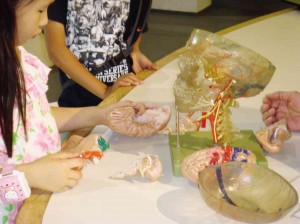Meeting Obama’s ‘friend’ and listening to learn
(Second of two parts)
Had I been traveling alone, I would have shied away from Miraikan (Wei-lai-guan in Chinese, meaning, museum of the future), the national museum of emerging science and innovation in Koto, Tokyo. It took us quite a while, via train and monorail, to reach this destination. But was I glad my daughter brought me there!
Three months ahead of us, US President Barack Obama had played soccer with the museum’s most famous humanoid robot, Asimo. The president, with whom the robot spoke in English, said it was a bit scary that Asimo was so humanlike.
At the Miraikan, hands-on participation is key to learning science.
I watched a 7-year-old child putting back the different lobes of a brain together. I had just been teaching my doctoral students the locations of brain lobes and now here was a boy assembling the parts adeptly.
Article continues after this advertisementI saw another child, about 10 years of age, doing stomach surgery using a simulation screen.
Article continues after this advertisementThere was another interactive screen for visitors to try diagnosing an illness and prescribing appropriate medications. Too much or too little, too frequent or too far apart, the dosage intervals would show a plunging diagram as the patient’s health deteriorated— and that was me giving the medication.
After a long day of experiments and information-seeking within the comfort of this glass structure, it was nice to lie down for a rest on one of the sofas provided in the atrium and look up at the giant globe made of hundreds of LED (light emitting diode) panels with changing colors and topography.
World Choral Symposium
From art galleries and science museums, I next went for a feast of auditory delights.
Every three years, the International Federation of Choral Music holds the World Symposium of Choral Music in a different part of the world.
I first attended the symposium in 1996 in Sydney, Australia. I attended it again in August.
This time, the symposium was held in Seoul, Korea. It was only the second time it was held in Asia. The previous time was in Kyoto, Japan, in 2005.
Cooped up at National Theater of Korea and Seoul Arts Center for a week, I certainly had no complaints. There were 20 international and 10 local Korean choirs. To enjoy three concerts each day for seven days was a major feast for the ears.
From a Johann Sebastian Bach motet to Ernani Aguiar’s “Salmo 150,” with performances by groups as varied as the Stuttgart Kammerchor and the Roomful of Teeth from the United States, from the powerful sounds of the Incheon City Chorale to the gentle Moran Choir of Israel, one could never get enough pleasure from absorbing how melodies could be so delightfully strange, rhythm so innovatively flexible and harmonies so ingeniously complex.
It was learning culture and arts at its best through the simple art of listening.
What I was most excited about was to listen again to Bernius’ Stuttgart Kammerchor. But what moved me the most was the Hong Kong Children’s Choir because I saw myself as a young chorister again, singing with them.
The most dramatic performance was the Incheon City Chorale’s rendition of Hyo-Won Woo’s “Creo,” with sound effects of nature, while the most applauded was the Oslo Chamber Choir’s “Den Ville Sauen” (The Lost Sheep).
And even when “Arirang,” which carries an inscription from the United Nations Educational, Scientific and Cultural Organization, was performed multiple times by different choirs at different levels of difficulty and from different choral arrangements (the only piece that was repeated), one never tired of listening to such a poignant piece that expressed the profound sadness and longing of a people.
A fitting inclusion in the repertoire was the World Vision Children’s Choir, originally organized for orphans, on the very last concert before the finale of Johannes Brahm’s “German Requiem.” A foretaste of heaven!
For young and old
Lifelong learning is usually associated with the continuing education of the middle-aged and elderly. Unfortunately, that is a misconception. Lifelong learning starts when a person is young—very young.
Our love for classical music was planted by listening to it in our formative years. The taste for fine arts was nurtured when our parents took us regularly to museums when we were young. The interest in science was developed in us when parents and teachers encouraged our curiosity.
After graduating from college and graduate school, looking for work and getting busier and busier, it is always good to take a break now and then from work and shopping to visit museums and music halls, to allow the arts to take us to another, better dimension of life, to see life from another perspective and to enjoy life in its fullness by appreciating what other, more creative people have produced for the world to see and hear.
We can always sit back and relax, even as our senses continue to feed our brains with innovative mental stimulation and tickle our minds with new provocations.
E-mail the author at [email protected].
